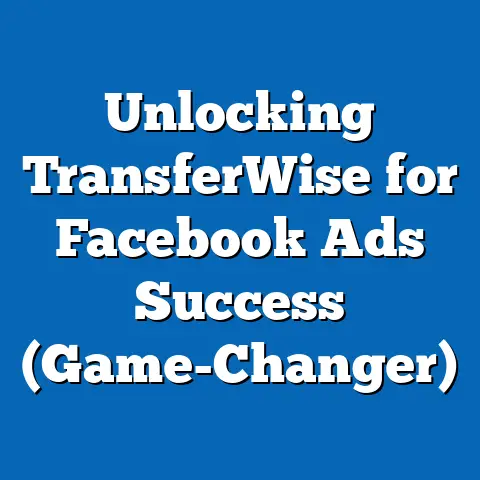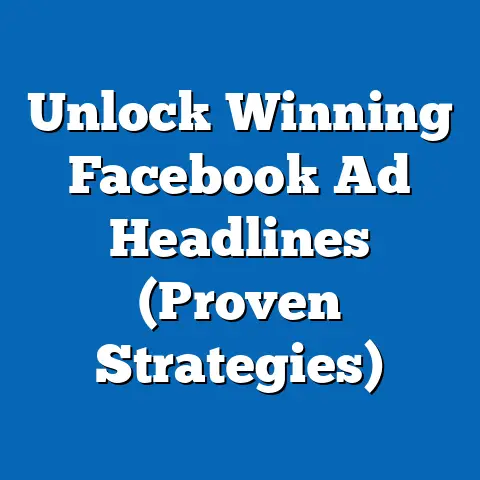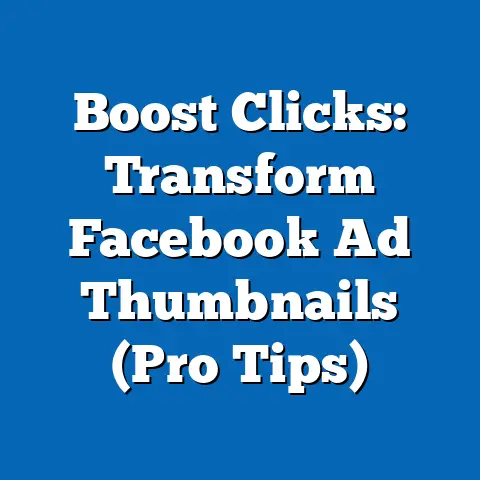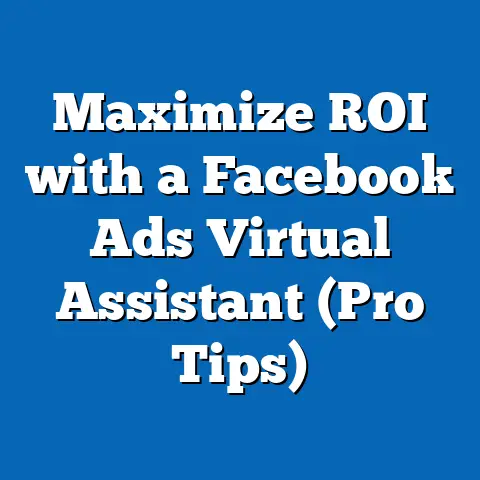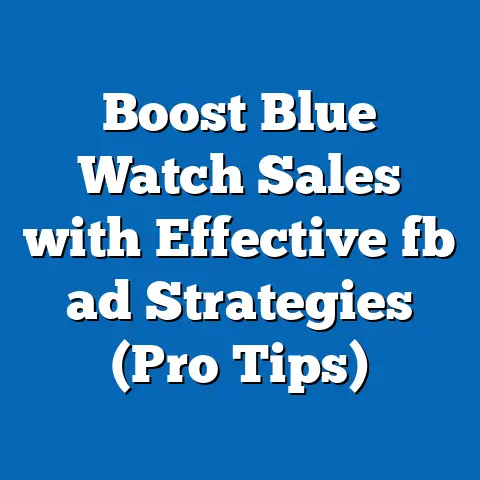Perfect Facebook Page Ad Size (Ultimate Guide Revealed)
Have you ever scrolled through Facebook and noticed how some ads just seem to pop, grabbing your attention instantly, while others fade into the background like wallpaper? I’ve been there, both as a user and as a marketer trying to get noticed. The secret, more often than not, lies in the details – and one of the most crucial details is the ad size. It’s not just about having a pretty picture; it’s about making sure that picture fits perfectly within Facebook’s ecosystem to maximize engagement and, ultimately, conversions.
This isn’t just some arbitrary design choice. The right ad size can be the difference between a campaign that soars and one that silently sinks. So, let’s dive into the ultimate guide to perfect Facebook ad sizes. I’ll break down why it matters, the optimal dimensions for different ad types, common mistakes to avoid, and the tools you need to succeed. Let’s get started!
The Importance of Ad Size in Facebook Advertising
In the fast-paced world of digital marketing, every pixel counts. Ad size isn’t just about aesthetics; it’s a fundamental element that impacts visibility, user engagement, and the overall performance of your Facebook campaigns. Think of it like this: you wouldn’t try to fit a square peg in a round hole, would you? Similarly, using the wrong ad size on Facebook can lead to distorted images, cropped content, and a less-than-ideal user experience.
Visibility and User Engagement
When your ad is correctly sized, it’s displayed in its full glory, capturing the user’s attention as they scroll through their feed. Proper sizing ensures that your message is clear, your visuals are appealing, and your call-to-action is easily visible. In contrast, an improperly sized ad can appear unprofessional and may even be overlooked entirely.
I remember one time I was working on a campaign for a local coffee shop. We had a fantastic image of their signature latte, but I rushed the ad creation process and didn’t pay close enough attention to the dimensions. The result? The image was stretched and blurry on mobile devices, making the latte look… well, unappetizing. Needless to say, the campaign didn’t perform as well as we hoped. This taught me a valuable lesson: ad size matters, especially on mobile, where most users are viewing content.
Facebook’s Algorithm and Ad Performance
Facebook’s algorithm is designed to prioritize high-quality, engaging content. Ads that meet Facebook’s specifications are more likely to be favored by the algorithm, leading to increased visibility and lower ad costs. On the other hand, ads with incorrect sizes or resolutions may be penalized, resulting in reduced reach and higher costs per click.
According to Facebook, “Ads with high-resolution images and videos perform better and are more likely to be approved.” This statement underscores the importance of adhering to Facebook’s guidelines. By ensuring that your ads meet these requirements, you’re not only improving the user experience but also increasing your chances of success.
Statistics and Case Studies
The impact of ad size on ad performance is well-documented. Studies have shown that ads with optimal dimensions and aspect ratios tend to have higher click-through rates (CTR) and conversion rates compared to those with incorrect sizes.
For example, a case study by HubSpot found that using the recommended image size for Facebook link ads resulted in a 20% increase in CTR compared to ads with non-optimized images. Similarly, a report by WordStream revealed that video ads with the correct aspect ratio had a 30% higher completion rate compared to videos with incorrect ratios.
These statistics highlight the tangible benefits of paying attention to ad size. By optimizing your ads for Facebook’s specifications, you can significantly improve your campaign performance and achieve better results.
Takeaway: Ad size is a critical factor in Facebook advertising that affects visibility, user engagement, and ad performance. Always ensure that your ads meet Facebook’s specifications to maximize your chances of success.
Overview of Facebook Ad Types
Facebook offers a variety of ad formats to suit different marketing objectives. Each ad type has its own set of recommended dimensions and aspect ratios. Let’s take a closer look at some of the most popular Facebook ad formats and their ideal specifications.
Image Ads
Image ads are the simplest and most common type of Facebook ad. They consist of a single image, ad copy, and a call-to-action button.
- Recommended Dimensions: 1200 x 628 pixels
- Aspect Ratio: 1.91:1
- Minimum Width/Height: 600 pixels
These dimensions ensure that your image looks crisp and clear on both desktop and mobile devices. When creating image ads, it’s important to use high-resolution images that are visually appealing and relevant to your target audience.
I’ve found that using lifestyle images that feature real people interacting with your product can be particularly effective. These types of images tend to resonate more with users and can help to increase engagement.
Video Ads
Video ads are a powerful way to capture attention and convey your message in a dynamic and engaging format.
- Recommended Dimensions: 1080 x 1080 pixels (square) or 1080 x 1920 pixels (vertical)
- Aspect Ratio: 1:1 (square) or 9:16 (vertical)
- Minimum Resolution: 1080p
- Maximum File Size: 4GB
- Recommended Video Length: 15 seconds or less
Square videos are ideal for mobile feeds, while vertical videos are perfect for Stories and Reels. When creating video ads, it’s important to optimize your content for mobile viewing. This means using clear visuals, concise messaging, and engaging animations.
I always recommend adding captions to your video ads, as many users watch videos with the sound off. Captions ensure that your message is still conveyed even when the audio is muted.
Carousel Ads
Carousel ads allow you to showcase multiple images or videos in a single ad unit. Users can swipe through the carousel to view each card, making this format ideal for showcasing multiple products or features.
- Recommended Image Dimensions: 1080 x 1080 pixels
- Recommended Video Dimensions: 1080 x 1080 pixels
- Aspect Ratio: 1:1
- Minimum Number of Cards: 2
- Maximum Number of Cards: 10
Carousel ads are a great way to tell a story or highlight different aspects of your brand. When creating carousel ads, it’s important to use high-quality visuals and compelling copy that encourages users to swipe through the entire carousel.
I’ve seen carousel ads used effectively to showcase a product’s features, demonstrate how to use a product, or tell a brand’s story. The key is to create a cohesive and engaging experience that keeps users swiping.
Slideshow Ads
Slideshow ads are similar to video ads, but they’re created using a series of static images. This format is a cost-effective way to create engaging video-like content without the need for a full-fledged video production.
- Recommended Dimensions: 1280 x 720 pixels
- Aspect Ratio: 16:9 or 1:1
- Image Format: JPG or PNG
- Maximum Number of Images: 10
Slideshow ads are easy to create and can be used to showcase products, tell stories, or promote events. When creating slideshow ads, it’s important to use high-quality images and add transitions and music to make the slideshow more engaging.
I often use slideshow ads when I need to create a quick and visually appealing ad without the time or budget for a full video production.
Takeaway: Facebook offers a variety of ad formats, each with its own set of recommended dimensions and aspect ratios. Choose the ad format that best suits your marketing objectives and ensure that your visuals meet the specified requirements.
Optimal Ad Sizes for Different Objectives
The best ad size for your Facebook campaign depends on your specific marketing objectives. Whether you’re aiming to increase brand awareness, promote a product, or generate leads, choosing the right ad size can significantly impact your results.
Brand Awareness
If your goal is to increase brand awareness, you’ll want to use ad sizes that are highly visible and engaging. Large, visually appealing ads tend to work well for this objective.
- Recommended Ad Type: Image Ads, Video Ads
- Recommended Dimensions: 1200 x 628 pixels (image), 1080 x 1080 pixels (video)
- Key Considerations: Use high-quality visuals that showcase your brand’s personality and values. Keep your messaging concise and memorable.
I’ve found that using eye-catching visuals and bold colors can help to grab attention and make a lasting impression on users.
Product Promotion
When promoting a specific product, you’ll want to use ad sizes that allow you to showcase the product’s features and benefits. Carousel ads and collection ads are particularly well-suited for this objective.
- Recommended Ad Type: Carousel Ads, Collection Ads
- Recommended Dimensions: 1080 x 1080 pixels (carousel), 1080 x 1920 pixels (collection)
- Key Considerations: Use high-quality product images or videos. Highlight the product’s key features and benefits. Include a clear call-to-action that encourages users to make a purchase.
I always recommend using multiple images or videos to showcase the product from different angles and in different contexts. This helps to give users a more complete understanding of the product and its value.
Lead Generation
If your goal is to generate leads, you’ll want to use ad sizes that include a lead form or a clear call-to-action that directs users to a landing page.
- Recommended Ad Type: Lead Ads, Image Ads with a Lead Form
- Recommended Dimensions: 1200 x 628 pixels (image)
- Key Considerations: Use a compelling headline and ad copy that entices users to fill out the lead form. Make sure your lead form is easy to complete and only asks for essential information.
I’ve found that offering an incentive, such as a free e-book or a discount code, can help to increase lead generation rates.
Takeaway: The optimal ad size depends on your specific marketing objectives. Choose the ad type and dimensions that best align with your goals and ensure that your visuals and messaging are optimized for the target audience.
Common Mistakes to Avoid
Creating effective Facebook ads requires attention to detail, and one of the most common pitfalls is using incorrect ad sizes. This can lead to a range of issues, from distorted images to poor ad performance. Let’s take a look at some common mistakes to avoid.
Using Outdated Dimensions
Facebook’s ad specifications are constantly evolving, so it’s important to stay up-to-date with the latest requirements. Using outdated dimensions can result in ads that are cropped, stretched, or otherwise distorted.
I make it a habit to check Facebook’s ad specifications regularly to ensure that my ads meet the latest requirements. You can find the most up-to-date information in Facebook’s Ads Manager help center.
Neglecting Mobile Optimization
With the majority of Facebook users accessing the platform on mobile devices, it’s crucial to optimize your ads for mobile viewing. This means using ad sizes that are optimized for mobile screens and ensuring that your content is easily readable on smaller devices.
I always test my ads on mobile devices to make sure they look good and function properly. You can use Facebook’s ad preview tool to see how your ads will appear on different devices.
Ignoring Aspect Ratios
Aspect ratio refers to the relationship between the width and height of an image or video. Using the wrong aspect ratio can result in ads that are cropped or distorted.
I always pay close attention to aspect ratios when creating Facebook ads. You can use graphic design software to ensure that your visuals have the correct aspect ratio.
Overlooking Image Resolution
Image resolution refers to the number of pixels in an image. Using low-resolution images can result in ads that appear blurry or pixelated.
I always use high-resolution images when creating Facebook ads. The minimum recommended resolution for Facebook ads is 1200 x 628 pixels.
Takeaway: Avoid common mistakes by staying up-to-date with Facebook’s ad specifications, optimizing for mobile viewing, paying attention to aspect ratios, and using high-resolution images.
Tools and Resources for Ad Creation
Creating Facebook ads of the right size and quality doesn’t have to be a daunting task. There are numerous tools and resources available to help you streamline the ad creation process and ensure compliance with Facebook’s guidelines.
Graphic Design Software
Graphic design software, such as Adobe Photoshop, Canva, and GIMP, can be used to create and edit images for Facebook ads. These tools allow you to resize images, adjust aspect ratios, and optimize visuals for different ad formats.
I personally use Canva for most of my ad creation tasks. It’s user-friendly, affordable, and offers a wide range of templates and design elements that make it easy to create professional-looking ads.
Facebook’s Ad Manager
Facebook’s Ad Manager includes built-in tools for creating and managing ads. The Ad Manager provides recommended dimensions and aspect ratios for different ad formats, as well as ad preview tools that allow you to see how your ads will appear on different devices.
I always use the Ad Manager to create and manage my Facebook ads. It’s a one-stop shop for all your advertising needs.
Online Resizing Tools
Online resizing tools, such as ResizeImage.net and PicResize.com, can be used to quickly and easily resize images for Facebook ads. These tools are particularly useful if you need to resize multiple images at once.
I often use online resizing tools when I need to quickly resize images for my Facebook ads. They’re fast, easy to use, and free.
Facebook’s Ad Library
Facebook’s Ad Library is a searchable database of all active ads on Facebook and Instagram. You can use the Ad Library to research what types of ads are being run by your competitors and get inspiration for your own campaigns.
I regularly use the Ad Library to stay up-to-date on the latest trends in Facebook advertising and get inspiration for my own ads.
Takeaway: Leverage tools and resources such as graphic design software, Facebook’s Ad Manager, online resizing tools, and Facebook’s Ad Library to streamline the ad creation process and ensure compliance with Facebook’s guidelines.
Testing and Optimization
Creating the perfect Facebook ad is an iterative process that involves testing and optimization. It’s important to continuously monitor your ad performance and make adjustments as needed to improve your results.
A/B Testing
A/B testing involves creating two or more versions of an ad and testing them against each other to see which one performs better. You can A/B test different ad sizes, visuals, headlines, and call-to-actions to identify the most effective combinations.
I always A/B test my Facebook ads to identify the best performing combinations. It’s a simple but effective way to improve your ad performance.
Performance Metrics
Facebook provides a wealth of performance metrics that you can use to track the success of your ads. Key metrics to monitor include reach, impressions, click-through rate (CTR), conversion rate, and cost per conversion.
I regularly monitor my Facebook ad performance metrics to identify areas for improvement. This allows me to make data-driven decisions about how to optimize my campaigns.
Ongoing Optimization
Optimization is an ongoing process that involves continuously monitoring your ad performance and making adjustments as needed. This may involve changing your ad sizes, visuals, headlines, or call-to-actions, or adjusting your targeting parameters.
I always approach Facebook advertising as an ongoing process of testing, learning, and optimization. By continuously monitoring my ad performance and making adjustments as needed, I can ensure that my campaigns are always performing at their best.
Takeaway: Continuously test and optimize your Facebook ads to improve your results. Use A/B testing to identify the best performing combinations, monitor key performance metrics, and make adjustments as needed.
Conclusion
Selecting the perfect ad size for your Facebook ads is a crucial step in creating effective and engaging campaigns. Understanding the importance of ad size, knowing the optimal dimensions for different ad types, avoiding common mistakes, and leveraging the right tools and resources can significantly impact your advertising success, increase engagement, and improve your ROI.
I hope this ultimate guide has provided you with the knowledge and insights you need to create Facebook ads that stand out from the crowd and achieve your marketing objectives. Remember to stay up-to-date with Facebook’s ad specifications, optimize for mobile viewing, and continuously test and optimize your campaigns to improve your results.
Now, it’s time to take action! Evaluate your current ad strategies and make adjustments based on the guidelines provided in this article. By implementing these strategies, you can create Facebook ads that are not only visually appealing but also highly effective at driving results. Happy advertising!

